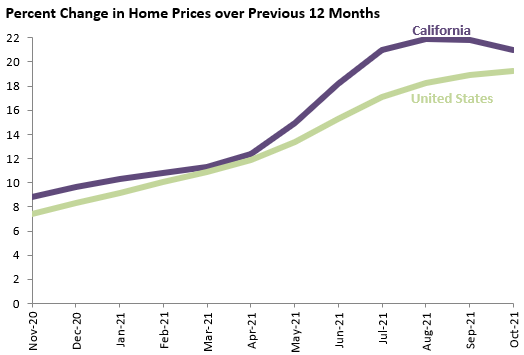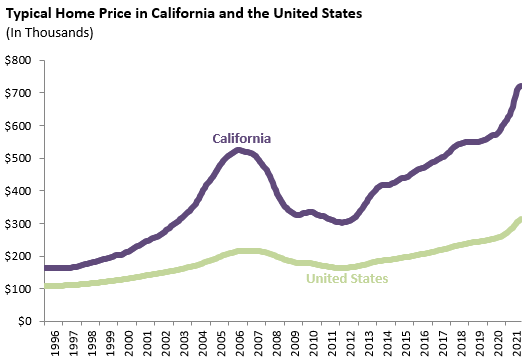Home prices are important to the California economy for a number of reasons. In the short and medium terms, home price increases often drive construction activity, which in turn spurs employment growth in a wide range of sectors. In the longer term, chronically high housing costs have hurt the state’s business climate and been a key reason California loses residents to other states on net in most years.
October 2021 data continue to show unusually high home price growth in both California and the rest of the country over the past year: the typical home in California has appreciated 21.0 percent since October 2020, somewhat above the national figure of 19.2 percent. California has seen higher 12-month growth rates before: price growth topped out at 25.2 percent in 2004 and 23.7 percent in 2013. In contrast, the nation’s highest previous growth rate since 1996 (the first year in Zillow’s database) was 11.9 percent in 2005. High materials prices, low interest rates that make monthly mortgage payments more affordable (all else equal), low inventory levels, and possibly the pandemic-driven shift to remote work have contributed to the price increases.
The next figure shows a sharp slowdown in California month to month home price growth over the past 3 months. The October state growth rate of 0.70 percent was the lowest since July 2020, if still high by historical standards. National home price growth has also slowed, although much less dramatically. The national October figure of 1.33 percent was the lowest since March, although still above any month in the series prior to March.
Housing in California has always been relatively expensive, and the gap has widened considerably since 2012. Previous recessions have had disparate effects on home prices: they were largely unaffected by the collapse of the dot-com bubble in 2001, while in the late 2000s the collapse of the housing bubble was the single biggest factor that led to the financial crisis. The affordability gap has widened again since the start of the pandemic, although this trend appeared to stop in the middle of this year.
The graph below shows appreciation over the past 12 months for the state’s 15 largest counties, and suggests that the shift to remote work has affected recent price changes. San Francisco has long been northern California’s largest business hub, and historically a large share of its work force has commuted in from other counties. With remote work becoming more common, there is less of a premium on living close to the office and as such home prices in San Francisco have not seen the explosive growth common in the rest of the nation. San Francisco’s average home price is up just 8.0 percent over the past year, and the neighboring and more expensive San Mateo is up 14.0 percent. All the other large counties in the state have seen growth above 15 percent. Six of the seven counties with the highest growth rates are in the state’s less expensive inland areas, with San Diego as the exception.




